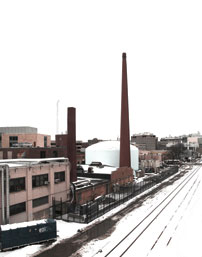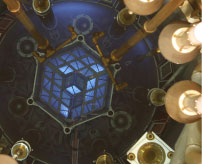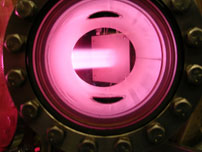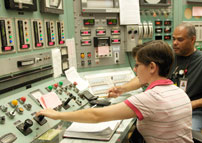History
Research and education in nuclear engineering at MITbegan in the 1940s. From the outset, our activities brought together pioneers from a range of fields and from across the Institute in the creation of this new field of scientific inquiry and engineering applications.
Today we remain focused on the generation, control, and application of nuclear reactions and radiation for the benefit of society and the environment. Our mission is to educate the next generation of leaders for the global nuclear enterprise, while laying the foundation for new applications of nuclear and radiation science and technology.
1935
Robley D. Evans offers the very first nuclear physics class at MIT; in 1955, he launches "Nuclear Physics for Engineers."
1949
Admiral Hyman G. Rickover visits MIT to arrange a master's track in nuclear science for naval officers.
1951
Course XXII, Nuclear Engineering, is launched within the Department of Chemical Engineering.
1951
Manson Benedict (1907–2006) becomes MIT's first professor of nuclear engineering. Benedict was a seminal figure in the development of the field of nuclear science and engineering. A veteran of the Manhattan Project, he later became the first head of the Department of Nuclear Engineering.
1953
Project Dynamo is launched to study the potential benefits of using a nuclear reactor for civilian electric power.
1953
Gordon Brownell invents the first positron-imaging machine, a key step toward positron emission tomography, an imaging technique still in use today.
1954
The launch of Project Separation to explore alternative processes for recovering uranium and plutonium from irradiated nuclear fuel.
1955
MIT approves the construction of an on-campus nuclear reactor for research purposes. Designed by Theodore Thompson, MITR-1 begins operations in 1958.
1955
MIT launches a doctoral program in nuclear engineering; the first degrees are awarded in 1958.
1958
Nuclear Engineering officially becomes a department.
1966
The Department institutes a summer training course (still offered today) on safety for professionals in the nuclear power industry.
1966
Working with the MIT Center for Space Research, Nuclear Engineering faculty help create a hydrogen-cooled reactor for the propulsion of space vehicles.
1973
ALCATOR plasma experiment begins operations at the Francis Bitter Magnet Lab.
1975
David Rose teaches the Department's first class on sustainable energy.
1975
Course XXII begins offering a full undergraduate program. The first BS is awarded in 1977.
1975
Norman Rasmussen leads the landmark 'WASH-1400' study, the first application of probabilistic risk assessment to reactor safety.
1975
MITR-2 begins operating. The redesigned reactor has a more compact core and is cooled by light water.
1978
Lawrence M. Lidsky serves as director of a new Plasma Fusion Center that provides support for ALCATOR and many other projects.
1983
Richard Lester directs the Nuclear Power Plant Innovation Project, an exploration of the role of new design concepts in making nuclear power more competitive.
1993
David Lanning and Michael Golay oversee the first "Reactor Technology Program for Utility Executives," a five-week summer course.
2000
The Center for Advanced Nuclear Energy Systems is formed to coordinate emerging research on nuclear power reactors and fuel cycles.
2003
MIT publishes "The Future of Nuclear Power," a major report on the challenges of scaling up the global nuclear power industry.
2004
The Department changes its name to Department of Nuclear Science and Engineering.
2010
MIT is selected as a lead partner in the Nuclear Energy Innovation Hub, a new DOE initiative to advance light water reactor design and engineering.
2010
MIT study on "The Future of the Nuclear Fuel Cycle" is released. The study, led by Mujid Kazimi and Ernest Moniz, considers the key technical choices available for an expanded nuclear power program in the U.S.
2011
NSE puts in place a new strategic plan that will extend its groundbreaking work in nuclear science and the engineering of nuclear systems, while also explicitly tying the department's education and research to the interactions of nuclear technology with society.
2016
New record for fusion — Alcator C-Mod tokamak nuclear fusion reactor sets world record on final day of operation.
2018
MIT launches SPARC — a compact, high-field net fusion energy project in collaboration with MIT spinout Commonwealth Fusion Systems.
2018
MIT study on "The Future of Nuclear Energy in a Carbon Constrained World" is released. The study, led by Jacopo Buongiorno and John Parsons, makes recommendations for new policy models and cost-cutting technologies.
2008: NSE celebrated its 50th Anniversary


Originally built in 1958 and renovated in 1975, the Department's on-campus nuclear reactor is a living laboratory. Researchers have used it to explore everything from radiation therapy for cancer patients to altering the structure of silicon for more capable electronics.

From the early days there was interest in nuclear fusion as an energy source, and the Department pioneered research on fusion engineering as well as plasma physics. The series of high-field "Alcator" tokamak plasma confinement experiments at MIT benefited from the participation of Nuclear Science and Engineering students and from NSE faculty leadership, and evolved into a world-leading fusion research program, achieving record confinement parameters and fundamental scientific breakthroughs.

The Department has been a leader in reactor safety since the early 1960s, when founding head Manson Benedict served as an advisor to the Atomic Energy Commission. In 1975, Professor Norman Rassmussen led a major government study of reactor safety and risk that remains a touchstone for nuclear regulation today.

Nuclear power is one of the most globalized of all industries. The Department has educated leaders of nuclear power programs across the globe and conducts significant research and educational collaborations on all five continents.
